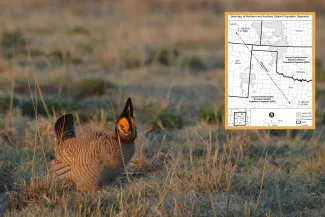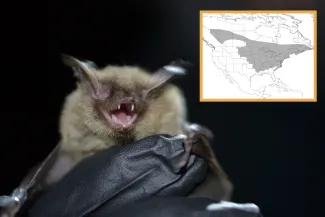The impressive catalog of plants and animals found in the United States has been indexed in a multitude of ways. The U.S. Fish and Wildlife Service’s Federal List of Endangered and Threatened Wildlife and Plants, or the threatened and endangered species list, is perhaps the most familiar of these indices and identifies the Nation’s most at-risk species. This well-known list has undergone multiple changes since its creation with the Endangered Species Act of 1973 and has again been updated in 2023.
Two of the list's recent changes involve Oklahoma species: the lesser prairie-chickens that occur in the state were classified as "threatened" on March 27, 2023, and the northern long-eared bat, initially classified as "threatened" across its range in 2015, was reclassified as "endangered" on March 31, 2023.
“Oklahoma’s federally listed species span six taxa groups,” said Curtis Tackett, endangered species biologist for the Wildlife Department. “We have threatened and endangered plants, fish, mussels, birds, mammals, and insects.
"Some of those species, like the lesser prairie-chicken, are especially sensitive to disturbances like habitat loss and fragmentation. Some, like the northern long-eared bat, may see significant declines because of factors like disease. And other species are thought to be historically rare.”
Regardless of the reason for listing, the status of each species is carefully reviewed by a team of biologists after having been petitioned by a citizen or group. The U.S. Fish and Wildlife Service may also internally initiate a review. This rigorous process includes a thorough “Species Status Assessment” that involves many conservation organizations and taxa experts and compiles the best available science to determine if a listing is warranted.
The assessments that informed the listing decisions for the lesser prairie-chicken and northern long-eared bat were completed in March and August 2022, respectively.

Lesser Prairie-chicken
The lesser prairie-chicken has a near 28-year history with the Endangered Species Act. It was first petitioned for listing in Oct. 1995, became a candidate for listing in 1998, received a “threatened” status in April 2014 which was then vacated in 2015, and was listed by distinct population segments in March 2023. The northern distinct population, which includes birds in Oklahoma, Colorado, Kansas, and portions of the Texas Panhandle, has been listed as “threatened,” while the southern distinct population, which includes birds in New Mexico and portions of Texas, has been listed as “endangered.” These populations are separated by at least 95 miles and are considered genetically distinct.
“A threatened listing means that without significant conservation actions, the species may become endangered in the foreseeable future,” Tackett said. “An endangered listing means that without significant conservation actions, the species may become extinct in the foreseeable future.”
The stocky grouse species can be found in five Great Plains states and requires large, intact, ecologically diverse grasslands to complete its life history and maintain healthy populations. Studies estimate the bird’s historic range has been reduced by 83 – 90% because of habitat loss, degradation, and fragmentation.

Northern Long-eared Bat
The northern long-eared bat has a 13-year history with the Endangered Species Act. It was first petitioned for listing in Jan. 2010, received a “threatened” status in May 2015, and was reclassified as “endangered” in March 2023.
“The northern long-eared bat doesn’t have the same habitat issues as the lesser prairie-chicken,” Tackett said. “A lot of the bat’s wintering habitat is protected and the trees they use in the summer to roost and raise pups aren’t considered limited. Instead, the U.S. Fish and Wildlife Service has determined a pathogen has caused their population to significantly decline.”
The bat can be found in 37 states and splits its time between caves in the winter months and trees in the spring, summer, and fall. In Oklahoma, it is thought to occur in seven eastern counties. The impact of white-nose syndrome, a disease caused by a fungal skin infection, was the primary factor that influenced the listing decision. The disease causes the bats to rouse during hibernation when the insects they hunt are in limited supply; the eventual depletion of fat reserves results in mortality.
In addition to providing data to help inform the status changes for the lesser prairie-chicken and northern long-eared bat, the Wildlife Department has also shared information with the U.S. Fish and Wildlife Service regarding the state’s known populations of other species.
- Data have been shared for species recently proposed for federal listing, including the alligator snapping turtle, tricolored bat, western fanshell mussel, and pyramid pigtoe mussel.
- Data are currently being shared regarding Oklahoma’s known populations of other petitioned species, including the Kiamichi crayfish, regal fritillary, little brown bat, southern plains bumble bee, and the peppered shiner.
- Data provided by the Wildlife Department for the Ozark emerald, Oklahoma salamander, and seaside alder were used by the U.S. Fish and Wildlife Service to determine the species were not warranted for listing action.
The Endangered Species Act is turning 50! We’ll be sharing facts and stories about Oklahoma’s threatened and endangered species in future issues of the Wild Side, and on our social media channels, @okwildlifedept.